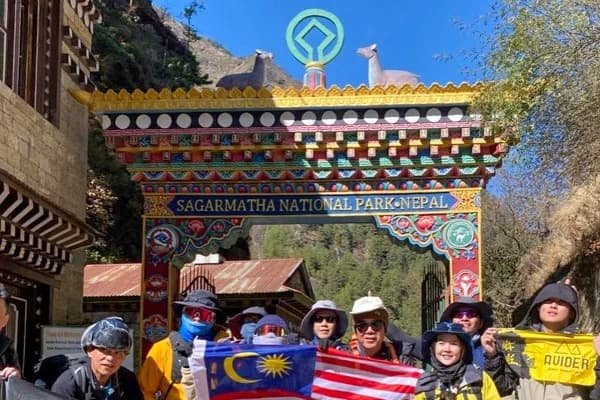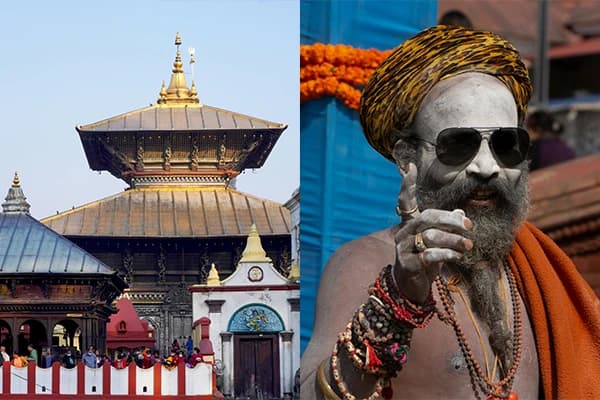Result of trekking without a permit and guide in Nepal
Trekking in Nepal without a guide or permit is considered illegal. The Nepal Tourism Board has announced that solo trekking is banned in Nepal and can be possible only by hiring a licensed guide or a porter. Trekking solo without a permit and guide results in fines, deportation, and even imprisonment.
The mandatory guide or porter for foreigners is done for their safety in the high altitude region of Nepal. With the necessary permits and following rules and regulations, one can enjoy trekking in the natural beauty of the Himalayas without any legal consequences.
Places to obtain trekking permits
The trekking permits can be obtained from different packers in Nepal. The entry permits to enter the national park of nepal are available at the entrance gate. The trekking permits can be purchased via the Nepal Tourism Office of Kathmandu or Pokhara.
The Department of Immigration of Kathmandu or Pokhara also provides trekking permit services. In Pokhara, you can buy trekking permits from the Trekking Agencies Association of Nepal (TAAN) or the ACAP (Annapurna Conservation Area Project) office.
Special permits like the Khumbu Pasang Lhamu Rural Municipality or TIMS Card are required for trekking in the Upper Mustang and everest region. Licensed trekking agencies will help your journey be smoother and will obtain all the permits and entry passes on your behalf.
Reason for getting permits while trekking in Nepal
Trekking permits are compulsory in Nepal, and they serve a key role in ensuring a safe and sustainable trekking experience in every corner of the country. It helps to conserve the environment and culture of the respective areas. Trekking permits in Nepal are important because of the following reasons.
- Environmental Conservation and Protection: It acts as a support system for environmental efforts and conservation plans in nature, like national parks and protected areas.
- Cultural Preservation: The permits aid in the preservation of the distinct culture and heritage of the indigenous communities of the restricted areas.
- Safety and emergency support: The permits help to track trekkers and assist them in case of emergency, as nature is full of risks associated with landscape and weather.
- Responsible Tourism: It helps in the regulation of trekker size in specific regions and avoids overcrowding. It also helps to minimize the impact on the ecosystem.
- Supporting Local Communities: The fee paid for permits acts as a charity to the communities of rural and remote areas. It helps in the rate of infrastructure development, like education and health services, followed by improvement of lifestyle.
- Route Management and Information: The permits are a medium to track the record of trekkers; this benefits trail management and the overall trekking experience.
- Compliance with Legal Requirements: It is made compulsory by the government of Nepal and helps sustainable tourism.
Types of Trekking Permits
The trekker's information management system (TIMS) card is needed for some himalayan trekking for all foreigners. In 2010, the National Tourism Board (NTB) and the Trekking Agencies Association of Nepal (TAAN) implemented the TIMS card, as it ensures the safety and security of the trekkers during their journey. It keeps a record of the trekkers while monitoring their movement and managing their number in the trekking districts.
The TIMS card helps to get the details of the trekkers, their nationality, passport number, and route used for tracking their movement in their journey. It costs $15 US for a single entry to a particular area. The permits cannot be returned or extended and are not transferable after they complete the issuing process.
The card is issued only if you provide a copy of your passport, visa, and two passport-sized pictures by the Nepal Tourism Board and TAAN. A TIMS card is necessary even though you have other permits for trekking in particular areas like the Langtang National Park Permit (LNPP).
When you obtain this permit, you will be eligible for trekking in the particular areas of your choice, and it helps to control the number of trekkers entering Nepal trekking regions. If you do not have a TIMS card, then you have to suffer from legal problems or penalties.
TIMS Permit fees: NPR. 2,000 per person (Foreigners) and NPR. 1,000 per person (SAARC countries)
The visitors or trekkers are allowed to enter the national parks of Nepal only if they have the National Park Permits. It is made mandatory for all national parks by the Department of National Parks and Wildlife Conservation (DNPWC). It costs around 10 USD to 35 USD per person daily. The trekkers or visitors must have other permits or visas with a clear staying period in Nepal. You must check all the appropriate authorities before planning on a vacation to Nepal.
|
S.N.
|
National Parks/ Wildlife Reserves
|
Nepali (per person/ per entry)
|
SAARC (per person/ per entry)
|
Foreigners (per person/ per entry)
|
Children Discount
|
|
1.
|
Chitwan National Park
|
NRs. 150
|
NRs.1,000
|
NRs. 2,000
|
Free for Below 10 years old
|
|
2.
|
Sagarmatha National Park
|
NRs. 100
|
NRs. 1,500
|
NRs. 3,000
|
Free for Below 10 years old
|
|
3.
|
Banke National Park
|
NRs. 100
|
NRs. 750
|
NRs. 1,500
|
Free for Below 10 years old
|
|
4.
|
Bardia National Park
|
NRs. 100
|
NRs. 750
|
NRs. 1,500
|
Free for Below 10 years old
|
|
5.
|
Khaptad National Park
|
NRs. 100
|
NRs. 500
|
NRs. 1,500
|
Free for Below 10 years old
|
|
6.
|
Langtang National Park
|
NRs. 100
|
NRs. 1,500
|
NRs. 3,000
|
Free for Below 10 years old
|
|
7.
|
Makalu-Barun National Park
|
NRs. 100
|
NRs. 1,500
|
NRs. 3,000
|
Free for Below 10 years old
|
|
8.
|
Parsa National Park
|
NRs. 100
|
NRs. 750
|
NRs. 1,500
|
Free for Below 10 years old
|
|
9.
|
Rara National Park
|
NRs. 100
|
NRs. 1,500
|
NRs. 3,000
|
Free for Below 10 years old
|
|
10.
|
Shey-Phoksundo National Park
|
NRs. 100
|
NRs. 1,500
|
NRs. 3,000
|
Free for Below 10 years old
|
|
11.
|
Shivapuri National Park
|
NRs. 100
|
NRs. 600
|
NRs. 1,000
|
Free for Below 10 years old
|
|
12.
|
Shuklaphanta National Park
|
NRs. 100
|
NRs. 750
|
NRs. 1,500
|
Free for Below 10 years old
|
|
13.
|
Dhorpatan Hunting Reserve
|
NRs. 100
|
NRs. 1,500
|
NRs. 3,000
|
Free for Below 10 years old
|
|
14.
|
Koshi Tappu Wildlife Reserve
|
NRs. 100
|
Rs. 750
|
NRs. 1,500
|
Free for Below 10 years old
|
- Restricted Area Trekking Permit (Special Permit)
Most of the northern and western areas of Nepal are considered restricted areas because they are near the Himalayan mountain ranges. The protection and safety of restricted areas come under the duties of the Nepal government, as they have special natural and cultural resources that need to be preserved.
Nature enthusiasts can hike in these restricted areas with the help of these permits and pay the appropriate amount of money.
The permit fee for the restricted areas of Nepal depends on the location and duration of the trek. It will be expensive if your stay is longer in a remote or more challenging region. Free individual trekkers must hire a porter or guide to hike in Nepal for their safety and security risk in the restricted region.
Nepal's government has declared some regions with natural and cultural importance as Restricted Areas or Controlled Areas. With the help of a local trekking agency, you can get a trekking permit in restricted areas from the Department of Nepal Immigration. The following table helps you to gain knowledge of fees in different regions:
|
S.N.
|
Restricted Trekking Area
|
Permit Fee
|
|
1.
|
Upper Mustang
- Lo Manthang Rural Municipality (All areas of ward no.1 to 5)
- Lo-Gekar Damodar Kunda Rural Municipality (All areas of ward no.1 to 5)
- Baragung Mukti Chetra Rural Municipality (All areas of ward no.3 and Satang Village of ward no.5)
|
- USD 500 per person (for the first 10 days)
- USD 50 per person /Day ( beyond 10 days)
|
|
2.
|
Upper Dolpo
- Dolpo Buddha Rural Municipality (All areas of ward no.4 to 6)
- Shey Phoksundo Rural Municipality (All areas of ward no.1 to 7)
- Charka Tangsong Rural Municipality (All areas of ward no.1 to 6)
|
- USD 500 per person (for the first 10 days)
- USD 50 per person /Day ( beyond 10 days)
|
|
3.
|
- Gorkha manaslu Area
- Chumnubri Rural Municipality (All areas of ward nos. 1,2,3 and 4)
|
September – November
- USD 100 per person/week
- USD 15 per person/day (beyond 1 week)
December – August
- USD 75 per person/week
- USD 10 per person/day (beyond 1 week)
|
|
4.
|
Humla
- Simikot Rural Municipality (All areas of ward no. 1,6 and 7)
- Namkha Rural Municipality (All areas of ward no. 1 to 6)
- Changkheli Rural Municipality (All areas of ward no. 3 to 5)
|
- USD 50 per person (for the first week)
- USD 10 per person /Day ( beyond one week)
|
|
5.
|
Taplejung (Olangchung Gola and Kanchenjunga)
- Phantanglung Rural Municipality (All areas of wards no. 6 and 7)
- Mikwakhola Rural Municipality (All areas of ward no. 5)
- Sirijunga Rural Municipality (All areas of ward no. 8)
|
- USD 20 per person/ week (for the first 4 weeks)
- USD 25 per person /week (beyond 4 weeks)
|
|
6.
|
Lower Dolpo Area
- Thuli Bheri municipality (All areas of ward no. 1 to 11)
- Tripurasundari municipality (All areas of ward no. 1 to 11)
- Dolpo Buddha Rural Municipality (All areas of ward no. 1 to 3)
- Shey Phoksundo Rural Municipality (All areas of ward no. 8 and 9)
- Jagdulla Rural Municipality (All areas of ward no. 1 to 6)
- Mudkechula Rural Municipality (All areas of ward no. 1 to 9)
- Kaike Rural Municipality (All areas of ward no. 1 to 7)
|
- USD 20 per person/ week
- USD 5 per person /day (beyond 1 week)
|
|
7.
|
Dolakha (Lapche Valley and Tashi Lapcha Pass)
- Gaurishankar Rural Municipality (All areas of ward no. 9)
- Bighu Rural Municipality (All areas of ward no. 1)
|
|
|
8.
|
Gorkha Tsum Valley Area
- Sirdibas-Lokpa-Chumling-Chekampar-Nile-Chule
- Chumnubri Rural Municipality (All areas of ward nos. 3,6 and 7)
|
September – November
- USD 40 per person/week
- USD 7 per person/day (beyond 1 week)
December – August
- USD 30 per person/week
- USD 7 per person/day (beyond 1 week)
|
|
9.
|
Sankhuwasabha (Makalu Area)
- Bhootkola Rural Municipality (All areas of ward no. 1 to 5)
- Makalu Rural Municipality (All areas of ward no. 4)
|
- USD 20 per person/ week (for the first 4 weeks)
- USD 25 per person /week ( beyond 4 weeks)
|
|
10.
|
- Solukhumbu (Thame and Tashi Lapcha Area)
- Khumbu Pasang Lhamu Rural Municipality (All areas of ward no. 5)
|
- USD 20 per person/ week (for the first 4 weeks)
- USD 25 per person /week ( beyond 4 weeks)
|
|
11.
|
- Rasuwa ( Rasuwaghat and Thuman Area)
- Gosaikunda Rural Municipality (All areas of ward no. 1 and some areas of ward no. 2)
|
|
|
12.
|
Manang (Nar and Phu Valley)
- Narpa Rural Municipality (All areas of ward no. 1 to 5)
- Nasho Rural Municipality (All areas of ward no. 6 and 7)
|
September – November
- USD 100 per person/week
- USD 15 per person/day (beyond 1 week)
December – August
- USD 75 per person/week
- USD 15 per person/day (beyond 1 week)
|
|
13.
|
- Bajhang (Mt. Saipal Area)
- Saipal Rural Municipality (All areas of ward no. 1 to 5)
|
- USD 90 per person/week for the first week
- USD 15 per person/day (beyond 1 week)
|
|
14.
|
- Mugu (Mugum Karmarong Rural Municipality)
- Mugumakarmarong Rural Municipality (All areas of ward no. 1 to 9)
|
- USD 100 per person/week
- USD 15 per person/day (beyond 1 week)
|
|
15.
|
- Darchula (Api and Nampal Himal Area)
- Vyas Rural Municipality (All areas of ward no. 1)
|
- USD 90 per person/week
- USD 15 per person/day (beyond 1 week)
|
Note: Permit fees change from time to time. Contact registered trekking agencies for an update of the trekking fee for your journey. You must hike or explore the restricted areas of Nepal if you hire a guide or porter; solo trekking is not allowed.
It is quite similar to a national park permit and is needed when entering the six conservation areas of Nepal. It is granted and managed by the National Trust for Nature Conservation (NTNC). NTNC is a nonprofit organization and is a product of a legislative act and was founded in 1982 AD. It assists the nature conservation sector in Nepal. You must have a conservation permit before entering this area, and below is the list of six conservation areas with the appropriate trekking fees:
|
S.N.
|
Conservation Area
|
Nepali (per person/ per entry)
|
SAARC (per person/ per entry)
|
Foreigners (per person/ per entry)
|
Children Discount
|
|
1.
|
Annapurna Conservation Area
|
NRs. 100
|
NRs.1,000
|
NRs. 3,000
|
Free Below 10 yrs old
|
|
2.
|
Api Nampa Conservation Area
|
NRs. 100
|
NRs. 500
|
NRs. 2,000
|
Free for Below 10 years old
|
|
3.
|
Manaslu Conservation Area
|
NRs. 100
|
NRs. 1,000
|
NRs. 3,000
|
Free for Below 10 years old
|
|
4.
|
Kanchenjunga Conservation Area
|
NRs. 100
|
NRs. 500
|
NRs. 2,000
|
Free for Below 10 years old
|
|
5.
|
Black Buck Conservation Area
|
NRs. 100
|
NRs. 500
|
NRs. 2,000
|
Free for Below 10 years old
|
|
6.
|
Gaurishankar Conservation Area
|
NRs. 100
|
NRs. 1,000
|
NRs. 3,000
|
Free for Below 10 years old
|
- Rural Municipality Trekking Permit
It is a special permit issued by the local administration of the rural municipality to enter and trek in the respective municipalities in Nepal. It is compulsory to enter the rural municipalities for trekking and traveling, while the cost varies according to the length of the trek and particular municipality. The local government office of the rural municipality is in charge of issuing this permit.
A Rural Municipality Trekking Permit allows to enter this region in Nepal. Different trekking routes require different permits to enter and trek, so you must have information regarding it, which will be provided by local trekking agencies. With a certified guide or porter and necessary permits, one can trek freely in the trekking areas in Nepal.
Required personal documents for general permits
Trekking permits are obtained only if you have a valid document. In Nepal, trekking permits allow you to trek at the choice of your destination if you have the following things:
- A valid copy of your passport's main page
- A copy of your valid visa is sufficient for your stay.
- A recent passport-size photo
- Itinerary and contact details
- Proof documents of travel and health insurance
- Trekking conditions in Nepal by the Department of Immigration
- proof of the payment for permits like TMS or National Park Fees.
The local as well as foreign trekkers should value the customs and traditions of local people. The traveler should avoid that thing that goes against the norms and cultural practices of society.
- The trekkers must obtain the required permits for all the routes, including the Everest, Annapurna, and Langtang. For the restricted areas, you will need special trekking permits. Trekking permits will not be issued beyond the expiration of your Nepalese visas.
- There should be at least two trekkers for the adventure; individual trekking is not allowed. and hiring a guide for the trek is necessary.
- The safety gear and the right clothing should be provided to those who are on a journey with you, like local guides or porters. Personal accident insurance should be provided as well.
- Trekkers should hike on the designed trekking route only. The trekking guide should stop you from hiking off-route, as it may bring many obstacles.
- At the time of hiking, one should follow the instructions properly given by the trekking leaders in the restricted areas.
- Those mountaineers who have gained the expedition permits must have trekking permits as well. This will help them to pass through restricted areas during their journey in peak climbing. In this case, the mountaineer should not pay for trekking fees.
Required documents for permit in Restricted Areas with Agency
The permit grants in restricted areas of the trekking region are issued by the immigration office's department if trekkers alone have the following documents. The documents from the agency will be managed by the agency itself.
- Photocopy of a valid passport, a valid Nepali visa sufficient to cover trekking itinerary days, and 2-4 of the most recent passport-sized photos.
- Documents relating to the insurance of the trekkers (foreign nationals) and Nepalese staff accompanying the trekkers.
- List of trekkers' names with the trekking itinerary.
- Agreement with Agency.
- Voucher of bank payment (fees) for permits.





